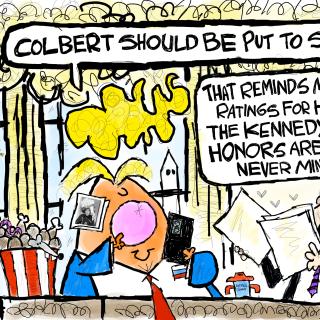Advertisement
I had the pleasure of meeting Arthur Ashe in the early 1980s. It was in a little tennis shop in a strip mall somewhere on Bethel Road. He was representing his brand, Le Coq Sportif, and the store was full of white children who weren’t even born when Ashe was on the professional tennis circuit. In fact, he and I were the only two black people in the store. I had just come from a tennis lesson, and we chatted about that briefly. He signed my copies of two books he had written, stopping to look at a photo of himself after heart surgery, and a poster for my tennis instructor, Dick Fryman. He couldn’t have been more gracious.
Arthur R. Ashe, Jr., was born in 1943 in Richmond, Virginia, the cradle of the Old Confederacy, to Mattie Cordell Cunningham and Arthur Ashe, Sr. He had a younger brother, Johnnie. His mother died in 1950 due to complications related to a toxemic pregnancy. He and his brother were reared by their father, a strict disciplinarian who emphasized education, and worked as a caretaker and special policeman for Brookfield Park, the larger of the two parks that severed the black community. The job allowed the Ashes to live in the caretaker’s cottage, and the park offered football–which his father forbade him from playing because he was so small–basketball, swimming, baseball, and tennis. Ashe took up tennis when he was seven, and was spotted by college player and instructor Ron Charity, who taught him the fundamentals.
From 1953 through 1960, Ashe was a summer tennis camp student at the home of Dr. Robert Walter Johnson, who coached Althea Gibson and founded the Junior Development Program of the all black American Tennis Association (ATA). It was Johnson who taught him the sports version of racial etiquette, a necessary survival skill for a black boy in a white sport in segregated America. Johnson expected his students to model the decorum and sportsmanship of Jackie Robinson. Among other rules, they were told to play any ball that was as far as two feet out and cautioned against arguing with the umpire. Ashe was a dutiful student. He not only had impeccable manners courtesy of his father, but he had an almost preternatural reserve. Johnson helped hone it into a steely-eyed unflappability, which served him well in every phase of his life.
Just about everyone who saw him in those early years predicted success for the skinny young boy from Richmond. Doris Cammack, a promising young black teenager from Harlem, entered a tournament sponsored by the ATA in June 1955. Because of an unequal number of players, there were no girls left in the draw, and she was made to play an exhibition match with Little Art, as he was sometimes called, who was then only eleven. In less than an hour, he had cleaned her clock, and Cammack gave up her dream of following Althea Gibson. He was on his way.
Arthur Ashe: A Life is a doorstop: at 629 pages, nine pages of acknowledgments, and seventy pages of notes, it’s like one of those Oxford Book of Whatevers that we had to read and lug around in college. In fact, there is almost too much detail, and at times I got lost in it. Still, to learn about the contributions Ashe made to multiple constituencies here and abroad is worth wading through this huge book, and Arsenault does an admirable job of telling Ashe’s story.
I was especially interested in reading about what happened to Ashe when in 1961 he left the stultifying racism of segregated Richmond to accept a tennis scholarship at the University of California, Los Angeles (UCLA), which had one of the top collegiate tennis teams in the country. Ashe said “I left all that Richmond stood for at the time–its segregation, its conservatism, its parochial thinking, its slow progress toward racial equality, its lack of opportunity for talented black people.” Yet by leaving Richmond, Ashe was giving up the mentorship of his coaches, Dr. Walter Johnson and Richard Hudlin, and leaving his family behind. He was on his own.
The population of LA was a multicultural stew. However, blacks were only six percent of the city’s population, and Black students made up less than one percent of the student body at UCLA. For some time, black students were barred from living on campus, although by the time Ashe arrived, this had changed. The black population of the city was confined to a district known as South Central by northern de facto segregation and racist real estate practices such as red lining and steering. While it was no racial nirvana, it wasn’t the Jim Crow south.
Ashe’s tennis game flourished. As in Richmond, he earned a string of African American firsts. Among others, he was the first black man to play on the United States Davis Cup team, and the first to win the National Collegiate Athletic Association’s (NCAA) men’s single title. Moreover, he was quite instrumental in the team’s NCAA national championship. He earned good grades, and upon graduating, became the first member of his father’s side of the family to finish college.
Ashe’s career is thoroughly represented here, from his boyhood to his win at the first United States Open in 1968 (because he was technically still an amateur, he could not accept the $13,000 winner’s purse); his role in the development of the men’s professional circuit; the epic 1975 Wimbledon final against the enfant terrible, Jimmy Connors, for which most observers didn’t think he had a chance; and his stint as a winning captain of the U. S. Davis Cup team. Also, old tennis names–men who had been friends and competitors of Ashe–I had long forgotten are sprinkled throughout the book: Pancho Gonzales, Marty Reissen, Stan Smith, Ken Rosewall, Rod Laver, Roscoe Tanner, John Newcombe.
After retiring from professional tennis, Ashe continued his activism, writing, and endorsements. In spite of these activities, he maintained a very private personal life. He was furious at being outed as possibly suffering from AIDS. He made the announcement on his own terms, and by so doing, brought verve and vigor to the efforts to cure the disease. He died at the young age of 49 of AIDS-related pneumonia.
His home state of Richmond chose to have Ashe lie in repose at the Governor’s Mansion—the last person to be so honored was Stonewall Jackson, the Confederate general, in 1863—a place he could not have visited when he was growing up there. In 1996 on the fifty- third anniversary of his birth, a statue of Ashe was dedicated on Richard’s Monument Avenue. (I’m sure the Confederates enshrined there are turning over in their graves.) The United States Tennis Association (USTA) named the main stadium in Billie Jean King National Tennis Center Arthur Ashe Stadium in 1997. In 2005 he was honored with a commemorative postal stamp as part of the United States Postal Service’s African American stamps series.
People still remember Arthur Ashe, the human rights advocate, too. Twenty-six years after his death, a UCLA student commencement speaker, Ashraf Beshay, who came to the United States to escape persecution for his role in the Egyptian Revolution, spoke about how the life of Arthur Ashe, his fellow Bruin, inspired him to pursue a life based on serving others.
What a remarkable life! Arthur Ashe, Jr. Gone too soon.



